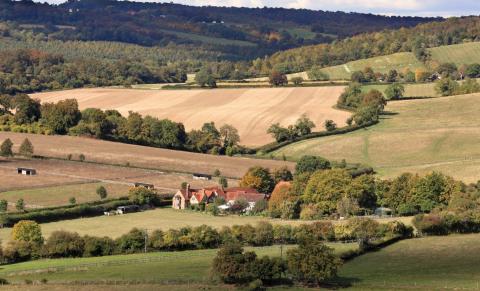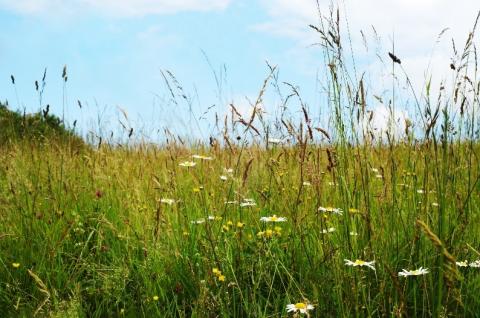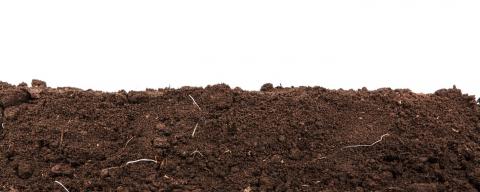8 November 2019
Louise Radley: IBERS, Aberystwyth University.
- To meet the Welsh Government's pledge to reduce greenhouse gas (GHG) emissions by 95% by 2050, a variety of methods and technologies will be required, including carbon capture and storage or utilisation on an industrial scale.
- Focus on climate change has mainly looked at alternatives to fossil fuel, but this is unlikely to be sufficient to mitigate current climate change trends. Carbon capture and storage/utilisation may offer solutions to reduce CO2 levels in the atmosphere and reduce GHG emissions.
- Several carbon capture methods for an agricultural business have been listed below and include:
- Planting hedgerows and trees to help sequester carbon for either long-term storage, or as an alternative carbon source for fossil fuels
- Improving soil and livestock management to improve soil carbon capture, thus reducing farm carbon footprint
The UK government has pledged to reduce national greenhouse gas (GHG) emissions by 80% from 1990 levels by 2050, with the Welsh Government proposing a reduction of 95% GHG emissions within the same period. Such ambitious targets will require a variety of technologies to achieve this, including developing technologies to reduce carbon and GHG output, in addition to technologies to uptake carbon and GHG emissions currently in the environment. Carbon capture technologies are equally as important for reducing the carbon footprint of an industry as reducing carbon output, and developing techniques and ideas for improving carbon intake should reduce the overall net GHG emissions per annum of a business.
‘Carbon Capture’ involves ‘capturing’ CO2 emissions at the source of GHG emitting industries, or from CO2 concentrations in the atmosphere. This can involve both technical processes at the site (e.g. pre-combustion systems or post-combustion scrubbing technologies), which can be transported off-site in a more stable carbon form or utilised in further processes (e.g. as fertiliser), and biological methods, such as in supporting natural peatland or ocean environments, or on an agricultural level, e.g. soil and livestock management).
Benefits of carbon capture and utilisation
With GHG emissions hitting a critical point, and governments across the globe plotting new ‘green’ targets each year, developing technologies to tackle GHG emissions on any scale is crucially important. Any technology that has the potential to have a positive impact on GHG should be taken seriously as we have a huge challenge ahead of us and need to explore as many alternative solutions as possible before we can realistically start tackling it on a global scale.
Carbon capture offers a solution that has the potential to reduce carbon concentrations in the surrounding environment. With proven carbon capture technologies, carbon may be sequestered into long-term crops, soils, and unmanaged habitats. There is a lot of support for passive carbon capture methods, such as enabling soil sequestration, and reducing intensive soil management, such as ploughing and other high intensity seeding/harvesting practices. Passive carbon capture methods, such as above, do not emit many GHG emissions, and such practices may even reduce overall farm energy consumption.
How can your farm increase carbon capture at home?
Planting hedgerows and trees
There are many benefits to planting more hedgerows and trees on farms, including on economic, ecological and environmental terms. Planting hedgerows and trees on your land doesn’t just offer shelter and protection to livestock and local fauna, but also has the added benefit of increasing carbon capture and storage in woody biomass as CO2 is fixed as a more stable organic carbon in accumulating biomass. Roadside or urban trees in particular are significant in reducing pollution, by capturing large particulate matter with significant benefits on air quality. A similar effect is also achieved when planting near high sources of carbon pollution, including dairy and poultry units, where GHG emissions can be high due to livestock methane output and livestock management. When considering planting trees and hedgerows on your property, it would be worth taking into account the feasibility of planting around the busiest areas, particularly around heavy use of farm machinery, slurry pits and dairy and poultry units.
Although unmanaged plots may sequester greater quantities of carbon, studies suggest that coppicing provides greater potential carbon savings due to the substitution of fossil fuels. Planting fruit trees will also provide an economic incentive as an additional commercial crop for exploitation.
Agroforestry
Agroforestry involves incorporating trees in traditional agriculture, including silvo-pastoral agroforestry, where animals are grazed under trees, which in turn offer shelter and fodder for livestock in return for animal-enriched soils, and silvo-arable agroforestry, where crops are grown under trees, in rows large enough for heavy machinery to tend the fields without disturbance. This offers shade to heat sensitive crops, improved utilisation and recycling of soil nutrients and offers wildlife corridors. Trees often have deeper rooting systems than arable crops, and therefore carbon sequestration and nutrient absorption can be achieved through multiple layers. Trees can also be planted along buffer strips, and to replace unused marginal land, such as bramble patches, where they can offer the benefits, without affecting the arable land area.
Agroforestry and similar tree cultivation methods are some of the greatest methods for capturing carbon on an agricultural level, with a shift from agriculture to agroforestry significantly increasing soil carbon in a designated area by approximately 34%, and a shift from grassland to agroforestry increasing soil carbon by approximately 10%.
Planting long-term perennial crops
Improved soil management and reducing frequency of seeding and ploughing will also increase carbon uptake of arable soils. Planting perennial crops should reduce the frequency of ploughing and re-seeding each year, and enable cultivation of underground tissues, potentially building up carbon reserves underground and enabling microbial communities to establish. Planting perennial biomass species would also offer the benefit of greater potential overall carbon savings, by mitigating fossil fuel use. For example, ‘Miscanthus x giganteus’ offers carbon sequestration rates of approximately 1.96 tonnes carbon per ha per year, with 15-25 tonnes per ha total biomass yields, that may be used to offset coal usage in UK power stations. By including perennial crops during crop rotations, soils have the chance to recuperate lost carbon from intensive harvesting and re-seeding practices.
Grass species
Species-rich grasslands often have high rates of productivity due to improved resource partitioning systems above ground and below ground from having a range of capture methods and demands on resources. This avoids over-depletion of soil carbon and nutrients at specific depths, and helps negate the risk of soils drying out. The improved soil nutrient availability leads to a growing crop with access to a full range of nutrients and minerals in plant-available forms, and thus a greater physiological potential. To a higher level, the improved forage grass is then available to the grazing livestock, and improved feedstock has the potential to reduce methane output in ruminant cattle by up to 20%. A healthy soil with a good root network should also improve irrigation requirements, and protection against land erosion.
In the same regard, crop rotation is vital for healthy and carbon rich soils. A range of crops from different families, and with different lifetimes, prevents the soil depleting resources in a single particular way. Each crop may require different nutrients and resources, and develop various rooting depths. Crop rotation of plants with a range of longevity, including long-term green manures, or medium-term perennials enables the soil to avoid over-intensive cultivation over long periods, and recover carbon and microbe quantities between annual crop cultivation. Rotational grazing also enables grassland leys to replenish sugars to the soil, and provide a food source to resident microbes, leading to a potential to increase soil carbon levels by 1% every three years (20t/ha/yr).
Winter cover cropping
Winter cover crops can increase soil carbon by improving soil organic matter and fertility and preventing seasonal erosion. Seasonal cover crops enable solar energy harvest throughout the year, sequestering carbon into the soil through generally dormant months, providing food for soil microbes and reducing carbon runoff or nitrogen leaching by forming a layer of protection above the soil level. A mixture of winter-killed crops, such as annual ryegrass, and winter-hardy crops, such as tall fescue, is recommended to convey the benefits of above-ground biomass decomposition and improve established root systems over the full season.
Soil management
Arable soils are often depleted of carbon and due to erosion from over-intensive farming methods. With an estimated 9.8 billion tonnes of carbon stored in UK soils, improving soil health will have significant impacts on carbon sequestration. Reducing the use of heavy machinery and intensive soil tilling reduces soil disturbance and damage to soil structure and will help maintain high microbial biomass and activity within the soil (see below), and avoid release of carbon from churning up stable land.
Strictly no-till systems can lead to increased weed problems, leading to increased herbicide treatments, and can reduce the beneficial impact of the increased carbon sequestration. Shallow non-inversion tillage, or direct drilling tilling techniques have been found to increase earthworm populations, and improve weed control, while not significantly impacting yield, compared to deep-tilling. Organic farms, where pesticide and herbicide usage is reduced, and shallow tilling is a more widely utilised method of annual tillage, have an average of 21% higher soil organic matter than non-organic soils.
Soil biodiversity
Maintaining high biodiversity within soils leads to more efficient conversion of organic material to stable carbon forms, (e.g. humus). Microorganisms such as earthworms are able to translocate carbon and nutrients deeper into the soil profile, and microbes and micro-organisms provide nutrients through metabolic waste activities and decomposition. Microbes and microorganism levels correlate to reduced soil erosion and improved soil structure, with availability to absorb increased organic matter.
Soil biodiversity can be increased through regularly supplied organic matter through the top 4” of soil, and/or directly introduced bacteria and fungi, such as mycorrhizal fungi and rhizobacteria. Low intensity soil cultivation (including reduced use of heavy machinery or excessive harvesting) helps maintain high biodiversity within the field.
Carbon as a soil enhancer
Biochar offers a long-term carbon storage solution, with carbon stored in a stable form. Biochar also enriches soil leading to improved crop production in grasses and crops, as it bonds to nutrients and minerals, and supports microbial metabolism through increased nutrient availability and by keeping compost moist. Biochar also increases nitrogen retention up to 65% in soils alongside reducing ammonia emissions and increased humification.
Carbon capture technologies may also be used to produce fertiliser and soil conditioner from CO2 captured from industrial power generators or waste phosphorus and ammonia. By utilising ‘green’ fertilisers over traditional fertilisers, the carbon footprint of the field will also be significantly reduced even if the fertiliser is not produced directly on site.
Keep peat wet
Peatland is a considerable carbon store, and drying peatland releases substantial quantities of CO2 into the atmosphere. The UK has 12% of global peatland, with 70,000 hectares of upland blanket bog estimated in Wales. Current UK peatlands are estimated to hold up to three billion tonnes of carbon and arable farming and drainage in the East Anglian fens alone results in the loss of 380,000 tonnes of soil carbon each year (9% of total soil carbon loss per annum across the UK), while damaged Welsh peatlands release 550,000 tonnes carbon each year. By leaving peat alone, the en masse loss of carbon can be avoided and within Wales alone; estimates suggest that restoration of three quarters of Wales’ peatland would reduce emissions by around 168,000 tonnes per year.
Calls have been made for policies to be updated to restore natural peatland across the nation, both as natural habitat and for carbon mitigation.
Livestock management
Livestock management offers several opportunities to improve carbon capture of both soil within livestock fields and improving carbon capture from extensive methane output of the livestock themselves. Over-grazing has significant impact on soil carbon concentrations, due to erosion and increased soil compaction of the area if heavily suppressed by larger livestock treading on it. Ensuring ideal stocking densities, to produce sustainable yields of product for the field capacity, will help prevent over-grazing and soil destruction across the field.
Improved feedstocks for cattle can also significantly reduce methane output. By improving grass leys to include a mixture of species, including a variety of grass and clover species, methane emitted can be reduced up to 20% due to improved digestion.
Utilising cow slurry for anaerobic digestion or manure spreading can also have a positive impact on your carbon footprint (see below), with biogas produced from the slurry directly replacing fossil fuel-produced heating and energy systems and the solid digestate forming a convenient fertiliser.
Regenerative grasslands
Over-grazed and over-managed grasslands are often dry and nutrition-poor. By managing regenerative grassland, soils have the chance to enrichen, providing healthier grass leys and leading to improved carbon storage at deeper soil levels. Grass captures moisture and prevents run-off and surface capping, which can have significant impacts on soil erosion, fertility and carbon storage. By managing livestock and regularly moving herds to fresh pastures, grass has the opportunity to replenish soil carbon and nutrients and recover from lost growth, leading to a more sustainable ley without the use of additional fertiliser.
The theory follows that of natural grazing herds which migrate between pastures and don’t tend to return until the grassland has recovered. Where grazing habits have changed due to domestication and fencing of cattle, over-grazed grasslands are becoming increasingly desertified, due to increased erosion and run-off from dry, barren soils, and leading to severe reductions in carbon capture and storage as seen in healthier soils.
Anaerobic digestion recycling and biogas
On-site anaerobic digestion recycling is an ideal method of reducing the carbon footprint of a business by producing your own natural fuel and compost locally and thus simultaneously reducing carbon use to transport farm waste out, and import fertiliser and fuel in. Anaerobic digestion has two main waste products; biogas, which can be used as fuel for energy production, both for farm use and for the national grid; and anaerobic cake, which will benefit soils if used as fertiliser, or can be further processed by combustion or gasification. Anaerobic co-digestion of both green waste and manure slurry may contribute to a significant reduction of GHG emissions, compared to open air slurry tanks or direct use of manure as fertiliser. Excess biogas and anaerobic digestate that is surplus to requirement may also be sold to a third party for additional income.
Summary
Carbon capture is just one method of reducing the carbon footprint of a farm, by utilising methods of storing carbon, in either long-term stable form, such as organic carbon, or for utilisation across sectors of the farm, such as biofuel or fertiliser. With direct impacts on environmental CO2, carbon capture should be considered as a method of interest with regard to providing carbon neutral agricultural practices.
Many methods of carbon capture in agriculture, such as limited soil tillage and utilising anaerobic digestate as fertiliser, have the potential to be economically advantageous, in addition to reducing total carbon output of the farm. Other methods, such as producing an anaerobic system and the initial establishment of hedgerows and trees may require a larger initial investment, but have the potential to reduce overhead costs and may even offer the opportunity as a potential income revenue when established.
Farming Carbon Toolkit is a farmer-led, non-profit platform aiming to encourage climate change awareness and connect and support farmers interested in reducing their carbon footprint. For parties interested in calculating their carbon footprint or developing practices tailored for their particular farm, it may be worth a closer look.





